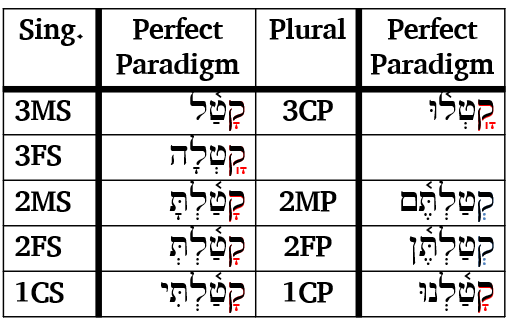13.13 Step 6: \(V_1 = \bar A\) (Qamets) in the Qal Perfect Strong Paradigm
The Qamets is wonderfully consistent in the Qal Perfect!
- There are other characteristics of the Qal perfect paradigm that will help us when we read the Bible
- \(V_1 = \bar A\) (Qamets) almost always
- Exception: as we learned way back in this course, an unaccented long vowel in an open propretonic syllable will undergo propretonic reduction
- When this happens, you will see a Vocal Sheva instead of Qamets
- Because we can identify propretonic reduction, we will be able to deduce that \(V_1\) used to be a long vowel - and if it’s a Qal verb, you’ll know it used to be a Qamets
- Study the chart below showing \(V_1\)
- The vertical line in 3FS and 3CP is called a “metheg” and is used to distinguish \(\bar A\) (Qamets) from \(O\) (Qamets Hatuf) when followed by a Sheva
- Note 2MP and 2FP have undergone propretonic reduction and have \(ə\) (Vocal Sheva) instead of \(\bar A\)
- When we get to Lesson 19 (Pronominal Suffixes), the Qamets will similarly reduce
